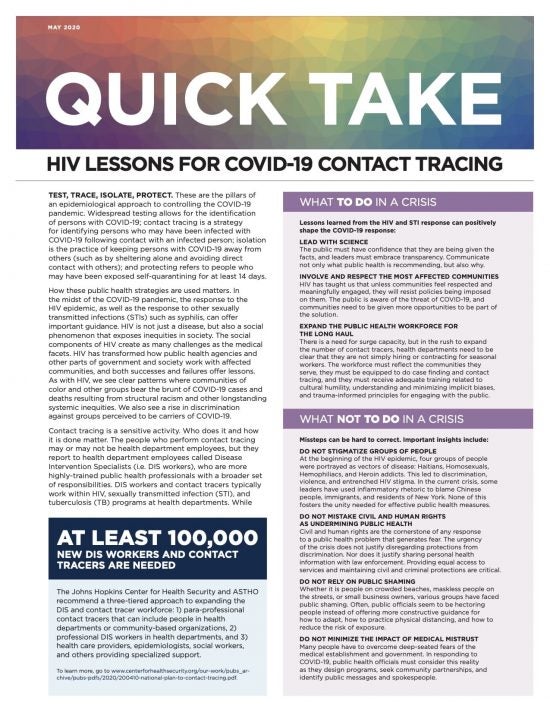 A critical component of the public health response to COVID-19 is contact tracing. Contact tracing is a strategy for identifying persons who may have been infected with COVID-19 following contact with an infected person. If done effectively, contact tracing could allow us to reduce the spread of COVID-19 and safely relax social distancing even before a cure or vaccine is developed.
A critical component of the public health response to COVID-19 is contact tracing. Contact tracing is a strategy for identifying persons who may have been infected with COVID-19 following contact with an infected person. If done effectively, contact tracing could allow us to reduce the spread of COVID-19 and safely relax social distancing even before a cure or vaccine is developed.
This week, the O’Neill Institute released a new brief, Quick Take: HIV Lessons for COVID-19 Contact Tracing. The brief describes what contact tracing is, who does it, and why it is important. Drawing lessons from the response to HIV and other STIs, the brief also discusses recommendations for what to do and not to do in responding to the COVID-19 crisis. Political leaders must lead with science, involve and respect the most affected communities, and expand the public health workforce for the long haul.
The contact tracing workforce includes different personnel, including para-professional contact tracers that can include people in health departments or community-based organizations, professional Disease Intervention Specialists (i.e., DIS workers) in health departments, health care providers, epidemiologists, social workers, and others providing specialized support. At least 100,000 new DIS workers and contact tracers are needed to support an effective COVID-19 response in the United States. Additional nurses are critical to help with medical monitoring of people with COVID-19 during self-isolation and their contacts during self-quarantine if they are at higher risk of severe disease. More care resource managers are also needed to assess social support needs and facilitate linkage to housing and other support services, such as delivery of food or medication and referral to programs that provide financial assistance. Earlier this month, the Centers for Disease Control and Prevention released Interim Guidance on Developing a COVID-19 Case Investigation and Contact Tracing Plan, which elaborates the roles and responsibilities of these and other key public health personnel.
The brief also discusses best practices for the use of technology in contact tracing. While digital contact tracing through smartphones may be a way to augment contact tracing efforts, the brief notes challenges and questions related to privacy, discrimination, interpersonal violence, and potential for harm, especially for people in marginalized communities and small communities. Partnerships between health departments and community-based organization and problems with law enforcement and criminalization are also discussed.
Lessons learned from HIV and other STIs have much to contribute to the COVID-19 response. We hope that the lessons and ideas discussed in our brief can be useful to health departments, elected officials, and the public. By protecting rights, partnering with communities, and expanding a well-trained workforce, public health can implement effective contact tracing for COVID-19.



